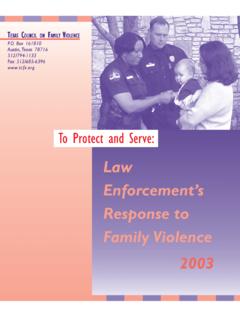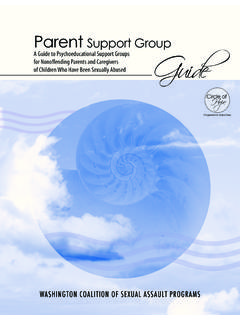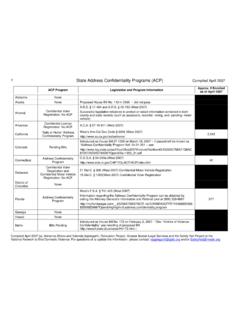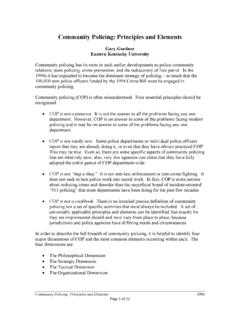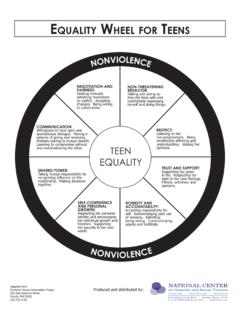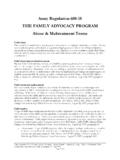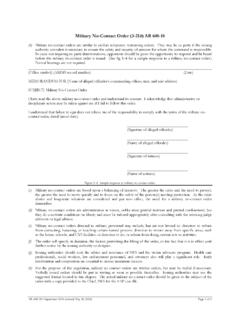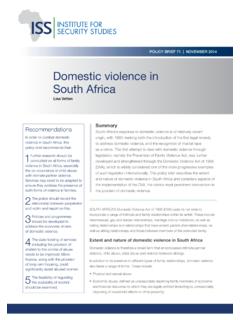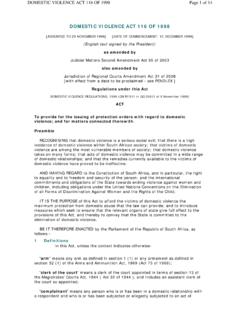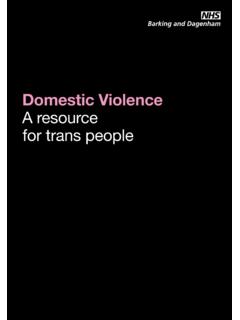Transcription of I. History of Sexual Assault Awareness and …
1 Janet Meyer, 11/06/00 Page 1I. History of Sexual Assault Awareness and prevention EffortsOriginsSexual Assault prevention is a relatively new field of practice and study, emergingout of the social movements of the late 1960s and 1970s. In the early ConsciousnessRaising groups of the feminist movement, women started speaking about theirexperiences, everything from housework to domestic violence to workplace inequities tosexual Assault . The first rape crisis centers were founded as a result of the efforts of theseearly feminist activists. The Boulder County Rape Crisis Team was the 4th such center toopen in the country in Brownmiller s Against Our Will, published in 1975, drew widespreadattention to the issue of rape.
2 In it, she systematically examined the historical and culturalcontexts in which rape and violence against women exist. Before Brownmiller and otherfeminist critics .. published work on the subject, rape was discussed, if at all, in terms ofaberrant and criminal behavior. [Benson, 1992] The ten years following publication ofthis book witnessed large increases in public Awareness of Sexual response to public concern, laws began to change. Slowly, some state lawswere changed to recognize marital rape, and rape shield laws were introduced. (Rapeshield laws are laws that bar defense attorneys from introducing evidence about thevictim s prior Sexual History .)
3 Congress passed the Rape Control Act in Concepts About Sexual ViolenceMany of the issues raised by feminist critics were later confirmed by key concepts emerged: (1) Rape and the fear of rape have an impact on everywoman s life, and that fear influences choice and restricts freedom; and (2) rapists are notnecessarily pathological, but may be extending and exaggerating culturally supportedgender role stereotypes. These critics also discussed the prevalence of myths about rape,which distort the facts and inappropriately move the focus of attention from the crime andthe assailant to the victim and her of the MovementIn the late 1970s and early 1980s, the United States experienced a tremendousincrease in survivors of Sexual violence publicly speaking out, sharing their stories ofvictimization.
4 This resulted in increased activism around the issues of Sexual violence,and the development of services for survivors. These efforts increased public Awareness ,reduced the trauma to survivors, and raised the demand for programs designed to preventsexual current level of public Awareness about acquaintance rape stems largely fromthe Ms. Magazine Project on Campus Sexual Assault in 1984. The project, led by MaryKoss, a renowned researcher, consisted of a self-report questionnaire distributed to a largeJanet Meyer, 11/06/00 Page 2number of college students across the United States.
5 The results transformed ourunderstanding of the scope of Sexual Assault in our society. Koss work revealed that rapewas a common experience, and one that did not match the stereotype of the ugly strangerjumping out of the bushes at night. Robin Warshaw managed to translate the results ofthe study into compelling stories of real people whose lives were profoundly affected bynon-stranger Sexual Assault . in her 1988 book, I Never Called It Rape. The term, acquaintance rape, became a popularly understood phrase, and the focus of preventionand treatment shifted in who worked in the field began to understand the root causes of sexualassault, developed and refined programs, and lobbied for support and funding ofprevention efforts .
6 Researchers attempted to further document rates of Sexual violence, todefine prevention , and to conceptualize theories that explained why such problemsoccurred. From this work emerged what has become an on-going debate about the rootcauses of the problem and the best way to prevent from the prevention field, such as George Albee and William Lofquist,argued that social problems of the time were the result of both structural problems ofsociety and individual defects. They provided theoretical frameworks for the creation,focus and implementation of prevention programs.
7 Nonetheless, much of their work hasbeen limited to prevention efforts focused on youth problem behaviors and chemicaldependency, and has not been applied to the field of Sexual AdvocatesActivists and rape crisis centers took on the responsibility to prevent sexualviolence. Rape crisis centers were founded on the belief that Sexual violence occurs as aresult of societal attitudes and the distribution of power in our culture. Preventing sexualviolence, from this perspective, necessitates changing the power dynamics and theunderlying attitudes of society.
8 Their initial prevention strategies focused on raisingpublic Awareness , with the goal being to inspire the public to take seriously the goal ofending Sexual survivors spoke out and public Awareness grew, an urgent desire emerged toprotect those who were perceived to be most vulnerable to victimization-- women andchildren. A wide variety of self-defense programs were offered to help women learn torecognize danger and how to respond to a potential Assault . These programs ranged fromthose that developed defensive skills, such as adaptations of traditional martial arts, tocontroversial re-enactments of potential assaultive situations, as well as self-empowerment programs that often combined education, consciousness-raising, and skillbuilding.
9 While sometimes characterized as prevention programs, these efforts are morecorrectly understood as rape avoidance Meyer, 11/06/00 Page 3 Sexual Assault as a Children s IssueThe 1980s saw a virtual explosion of efforts to prevent child abuse and childsexual abuse. In response to widespread media coverage of the issue, including somehorrific cases of alleged child Sexual abuse, numerous programs emerged. Curricula weredeveloped and implemented, children s books were printed, educational videos weremade, and pamphlets were distributed to children.
10 These programs were not built onrigorous systematic testing, but rather, sprang out of an urgent desire to respond to thesealarming LegislationThe 80s were also marked by the passage of legislation aimed at preventingsexual violence through legal deterrence. Across the country, laws were enacted toincrease penalties for criminals, and the definition of rape was ResponseThe 1980s saw federal dollars allocated to the prevention of Sexual violence. Thefederal prevention block grants had special set-aside funding for the prevention of sexualviolence.

